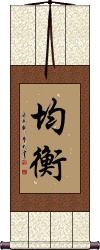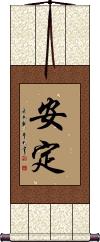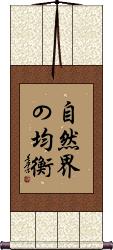Many custom options...
And formats...

Equilibrium in Chinese / Japanese...
Buy an Equilibrium calligraphy wall scroll here!
Personalize your custom “Equilibrium” project by clicking the button next to your favorite “Equilibrium” title below...
Balance / Equilibrium
均衡 means balance or equilibrium.
This title is best for a Japanese audience where the word suggests that your life is in balance in all matters (or is a reminder for you to try and keep all matters in balance).
Stability / Calm and Orderly / Equilibrium
安定 is a word that means: quiet; settled; maintain; calm and orderly; stability; equilibrium.
Life in Balance / Balancing Life
The art of balancing your life
This 平衡人生 title suggests that you are actively trying to keep your life in balance.
Think of this as the action verb of seeking or having a balanced life.
The first two characters mean balance, equilibrium, or keeping things equal.
The last two characters mean “life.” Literally “human life.”
The Universe in Balance / Balanced Universe
宇宙平衡 is a proverb that is simply Universe Balanced (we might say “Balanced Universe” in English).
The first two characters mean the Universe. However, in some contexts, it can mean cosmic, cosmos, or outer space.
The second two characters mean balance or balanced (can also mean equilibrium).
Nature in Balance / Balanced Nature
自然界の均衡 is a verbose way to say “nature in balance” in Japanese.
The first three Kanji have the meaning of “the natural world” or “the natural kingdom” (kind of like the animal kingdom but including plants and all things biological).
The third character is a Hiragana that acts to connect the two ideas here.
The last two Kanji mean equilibrium or balance.
Not the results for equilibrium that you were looking for?
Below are some entries from our dictionary that may match your equilibrium search...
| Characters If shown, 2nd row is Simp. Chinese |
Pronunciation Romanization |
Simple Dictionary Definition |
三昧 see styles |
sān mèi san1 mei4 san mei sanmai さんまい |
More info & calligraphy: Samadhi(1) (さんまい only) {Buddh} samadhi (state of intense concentration achieved through meditation) (san:); (suffix noun) (2) (usu. ざんまい) being immersed in; being absorbed in; indulging in; doing to one's heart's content; (suffix noun) (3) (usu. ざんまい) prone to; apt to; (given name) Sanmai (三昧地) Samādhi, "putting together, composing the mind, intent contemplation, perfect absorption, union of the meditator with the object of meditation." (M. W.) Also 三摩地 (三摩提, 三摩帝, 三摩底). Interpreted by 定 or 正定, the mind fixed and undisturbed; by 正受 correct sensation of the object contemplated; by 調直定 ordering and fixing the mind; by 正心行處 the condition when the motions of the mind are steadied and harmonized with the object; by 息慮凝心 the cessation of distraction and the fixation of the mind; by 等持 the mind held in equilibrium; by 奢摩他, i.e. 止息 to stay the breathing. It is described as concentration of the mind (upon an object). The aim is 解脫, mukti, deliverance from all the trammels of life, the bondage of the passions and reincarnations. It may pass from abstraction to ecstasy, or rapture, or trance. Dhyāna 定 represents a simpler form of contemplation; samāpatti 三摩鉢底 a stage further advanced; and samādhi the highest stage of the Buddhist equivalent for Yoga, though Yoga is considered by some as a Buddhist development differing from samādhi. The 翻譯名義 says: 思專 when the mind has been concentrated, then 志一不分 the will is undivided; when 想寂 active thought has been put to rest, then 氣虛神朗 the material becomes etherealized and the spirit liberated, on which 智 knowledge, or the power to know, has free course, and there is no mystery into which it cannot probe. Cf. 智度論 5, 20, 23, 28; 止觀 2; 大乘義章 2, 9, 1 3, 20, etc. There are numerous kinds and degrees of samādhi. |
均衡 see styles |
jun héng jun1 heng2 chün heng kinkou / kinko きんこう |
More info & calligraphy: Balance / Equilibrium(n,vs,vi) equilibrium; balance |
安定 see styles |
ān dìng an1 ding4 an ting yasusada やすさだ |
More info & calligraphy: Stability / Calm and Orderly / Equilibrium(n,vs,vi) (1) stability; steadiness; consistency; equilibrium; balance; composure; (adj-na,n,vs,vi) (2) {physics;chem} stable; (surname, given name) Yasusada stability |
捨 舍 see styles |
shě she3 she sha しゃ |
to give up; to abandon; to give alms {Buddh} equanimity; upeksa; upekkha upekṣā, neglect, indifference, abandoning, M.W. To relinquish, renounce, abandon, reject, give. One of the chief Buddhist virtues, that of renunciation, leading to a state of "indifference without pleasure or pain" (Keith), or independence of both. v. 舍. It is defined as the mind 平等 in equilibrium, i.e. above the distinction of things or persons, of self or others; indifferent, having abandoned the world and all things and having no affections or desires. One of the seven bodhyaṅgas. Translit. sa, śa, s(r). |
均勢 均势 see styles |
jun shì jun1 shi4 chün shih kinsei / kinse きんせい |
equilibrium of forces; balance of power uniformity; balance (equilibrium) of power |
對消 对消 see styles |
duì xiāo dui4 xiao1 tui hsiao |
in equilibrium; to cancel out (of opposite forces) (physics) |
平均 see styles |
píng jun ping2 jun1 p`ing chün ping chün heikin(p); heigin(ok) / hekin(p); hegin(ok) へいきん(P); へいぎん(ok) |
average; on average; evenly; in equal proportions (noun, transitive verb) (1) average; mean; (n,vs,vi) (2) balance; equilibrium |
平衡 see styles |
píng héng ping2 heng2 p`ing heng ping heng heikou / heko へいこう |
balance; equilibrium (noun/participle) even scale; equilibrium; balance; equalization; equalisation |
等持 see styles |
děng chí deng3 chi2 teng ch`ih teng chih tōji |
Holding oneself in equanimity, a tr. of samādhi, as also is 三等持, i.e. samādhi-equilibrium; also of samāpatti, v. 三摩鉢底 and 等至. |
釣合 see styles |
tsuriai つりあい |
balance; equilibrium |
優畢捨 优毕舍 see styles |
yōu bì shě you1 bi4 she3 yu pi she upisha |
(or 優畢叉) upekṣā. The state of mental equilibrium in which the mind has no bent or attachment and neither meditates nor acts, a state of indifference. Explained by 捨 abandonment. |
兼合い see styles |
kaneai かねあい |
(noun/participle) equilibrium; good balance; poise |
動平衡 动平衡 see styles |
dòng píng héng dong4 ping2 heng2 tung p`ing heng tung ping heng |
dynamic equilibrium; dynamic balancing |
安定性 see styles |
anteisei / antese あんていせい |
stability; security; equilibrium |
平衡態 平衡态 see styles |
píng héng tài ping2 heng2 tai4 p`ing heng t`ai ping heng tai |
balance; (state of) equilibrium |
調整弁 see styles |
chouseiben / choseben ちょうせいべん |
(1) control valve; regulating valve; (2) something that maintains equilibrium or balance |
釣合い see styles |
tsuriai つりあい |
balance; equilibrium |
釣合う see styles |
tsuriau つりあう |
(v5u,vi) (1) to balance; to be in harmony; to be in equilibrium; (2) to suit; to go well together; to be a good match |
非平衡 see styles |
fēi píng héng fei1 ping2 heng2 fei p`ing heng fei ping heng |
non-equilibrium; disequilibrium; unbalance |
つり合う see styles |
tsuriau つりあう |
(v5u,vi) (1) to balance; to be in harmony; to be in equilibrium; (2) to suit; to go well together; to be a good match |
不穩平衡 不稳平衡 see styles |
bù wěn píng héng bu4 wen3 ping2 heng2 pu wen p`ing heng pu wen ping heng |
unstable equilibrium |
兼ね合い see styles |
kaneai かねあい |
(noun/participle) equilibrium; good balance; poise |
動的平衡 see styles |
doutekiheikou / dotekiheko どうてきへいこう |
{chem;physics} dynamic equilibrium |
化学平衡 see styles |
kagakuheikou / kagakuheko かがくへいこう |
chemical equilibrium |
国内均衡 see styles |
kokunaikinkou / kokunaikinko こくないきんこう |
domestic equilibrium; internal balance; internal equilibrium |
均衡価格 see styles |
kinkoukakaku / kinkokakaku きんこうかかく |
equilibrium price |
市場均衡 see styles |
shijoukinkou / shijokinko しじょうきんこう |
market equilibrium |
平衡定数 see styles |
heikouteisuu / hekotesu へいこうていすう |
equilibrium constant |
平衡感覚 see styles |
heikoukankaku / hekokankaku へいこうかんかく |
(yoji) sense of equilibrium; sense of balance |
拡大均衡 see styles |
kakudaikinkou / kakudaikinko かくだいきんこう |
an expanded or expanding equilibrium |
Click here for more equilibrium results from our dictionary
The following table may be helpful for those studying Chinese or Japanese...
| Title | Characters | Romaji (Romanized Japanese) | Various forms of Romanized Chinese | |
| Balance Equilibrium | 均衡 | kin kou / kinkou / kin ko | héng / jun1 heng2 / jun heng / junheng | chün heng / chünheng |
| Stability Calm and Orderly Equilibrium | 安定 | an tei / antei | ān dìng / an1 ding4 / an ding / anding | an ting / anting |
| Life in Balance Balancing Life | 平衡人生 | hei kou jin sei heikoujinsei hei ko jin sei | píng héng rén shēng ping2 heng2 ren2 sheng1 ping heng ren sheng pinghengrensheng | p`ing heng jen sheng pinghengjensheng ping heng jen sheng |
| The Universe in Balance Balanced Universe | 宇宙平衡 | u chuu hei kou uchuuheikou u chu hei ko | yǔ zhòu píng héng yu3 zhou4 ping2 heng2 yu zhou ping heng yuzhoupingheng | yü chou p`ing heng yüchoupingheng yü chou ping heng |
| Nature in Balance Balanced Nature | 自然界の均衡 | shizenkai no kinkou shizenkainokinkou shizenkai no kinko | ||
Successful Chinese Character and Japanese Kanji calligraphy searches within the last few hours...








